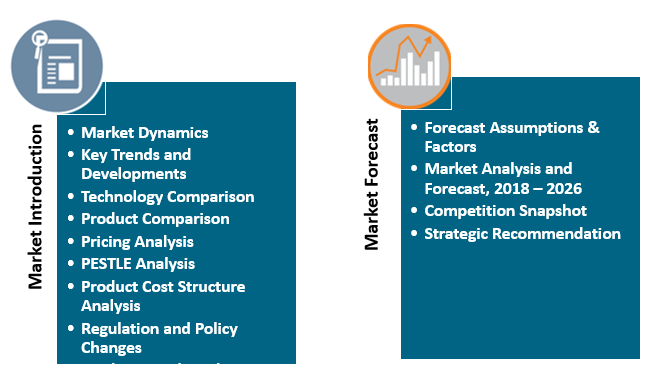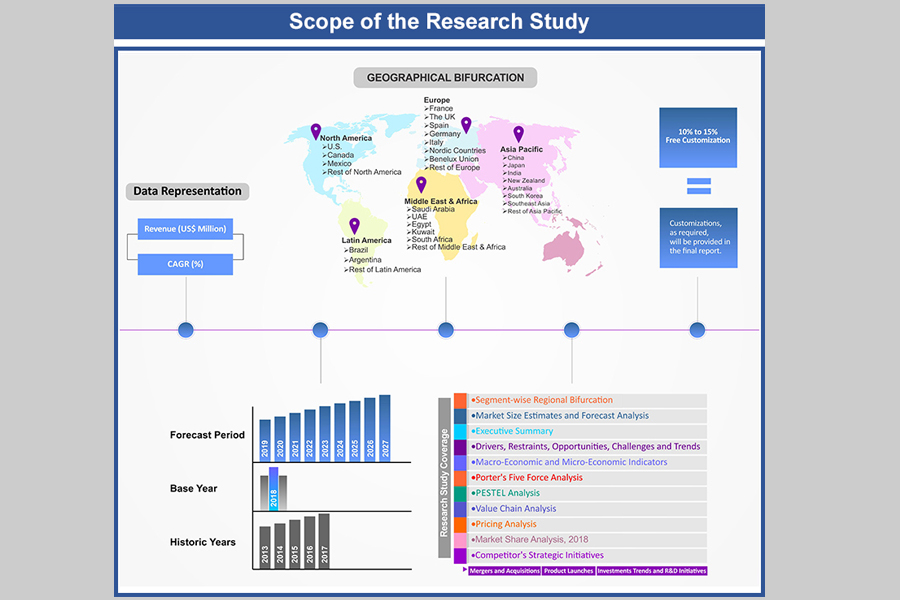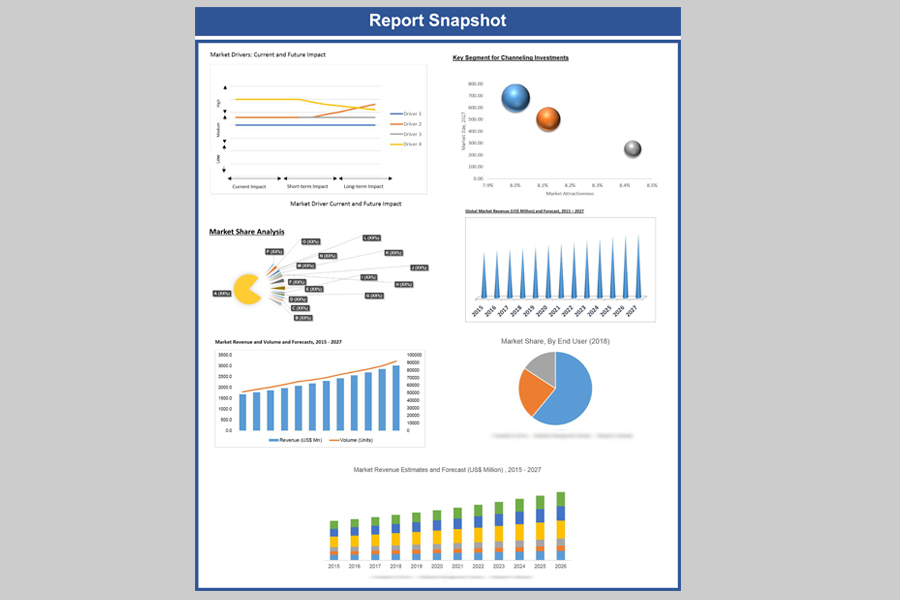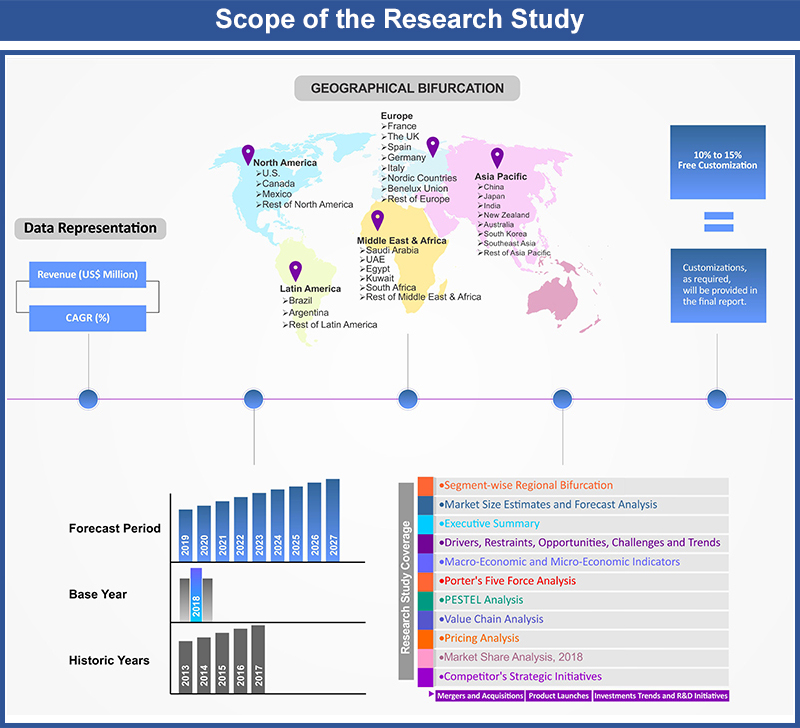Fetal Surgery Market by Method (Invasive and Minimally Invasive), by Surgical Procedure [Intrauterine Transfusion, Fetoscopic Laser Photocoagulation for TTTS, Fetal Shunt Placement, Amniotic Band Resection, Ex-Utero Intrapartum Treatment (EXIT), Fetoscopic Tracheal Occlusion (FETO), and Fetoscopic Spina Bifida Repair], by Facilities (Clinics, Children's Hospitals, and Others), by Country (U.S., Canada, and Mexico) – North America Insights, Growth, Size, Comparative Analysis, Trends and Forecast, 2019 – 2027
Market Overview/Industry Trends:
Fetal surgery, also called as antenatal surgery or prenatal surgery or fetal reconstructive surgery is the surgical treatment of the fetus before birth. In general, there are two types of fetal surgery, namely, open fetal surgery and minimally invasive fetoscopic surgery. In open fetal surgery, the fetus is partially removed from the uterus in order to expose the area of the fetus. Post-surgery, the fetus is returned to the womb and the uterus is closed. Minimally-invasive fetal surgery are typically performed to treat twin-twin transfusion syndrome or twin reversed arterial perfusion sequence. Factors influencing the market growth is improved level of surgeries, high prevalence of spina bifida, and increasing preterm births. For instance, the incidence of preterm births in the U.S. surged from the early 1980 through 2006 but declined from 2007 through 2014. Recent data for 2014–2016 indicates that preterm rate has increased again. From 2014 to 2016, the preterm birth rate rose 3% in the U.S., from 9.57% in 2014 to 9.63% in 2015 to 9.85% in 2016. On the contrary, the presence of rigorous regulatory procedures pertaining to fetal surgeries in North America is anticipated to impede the fetal surgery market growth over the forecast period.
In terms of value, the North America fetal surgery market accounted for US$ 2,356.0 Mn in 2018 and is expected to reach US$ 5,079.5 Mn by 2027 growing at a CAGR of 8.9% over the forecast period.
Fetal Surgery Market Revenue & Forecast, (US$ Million), 2015 – 2027
Method Outlook:
On the basis of methods, the North America fetal surgery market has been categorized into invasive and minimally invasive. In 2018, the invasive segment grabbed more than 62.0% of the fetal surgery market share and is expected to continue its dominance throughout the forecast period. This is growth is attributed to invasive surgeries that are being highly performed for the treatment of neural tube defects, congenital cystic adenomatoid malformation, congenital diaphragmatic hernia, congenital heart disease or congenital heart defect (CHD), pulmonary sequestration, and sacrococcygeal teratoma.
On the other hand, minimally invasive method segment is likely to exhibit significant market growth during the forecast period as this surgery uses small incisions and is guided by fetoscopy and sonography to treat fetal conditions such as twin-twin transfusion syndrome and spina bifida.
Surgical Procedure Outlook:
By surgical procedure, the North America fetal surgery market has been classified into intrauterine transfusion, fetoscopic laser photocoagulation (FLP) for twin-to-twin transfusion syndrome (TTTS), fetal shunt placement, amniotic band resection, ex-utero intrapartum treatment, fetoscopic tracheal occlusion, and fetoscopic spina bifida repair. The fetoscopic spina bifida repair segment commanded the market in 2018 owing to high prevalence of spina bifida in the United States. Spina bifida, a type of neural tube defect (NTD), is a condition that affects the spine and is usually apparent at birth. As per the data presented by Centers for Disease Control and Prevention (CDC), about 1,645 babies are born with spina bifida every year. This high prevalence of this condition is bolstering the demand for fetal surgery in the U.S., thereby contributing to the regional growth.
Facilities Outlook:
Based on facilities, the North America fetal surgery market has been bifurcated into clinics, children's hospitals, and others. In 2018, the clinics segment has secured the second position in terms of revenue in the fetal surgery market due to significant presence of fetal care clinics along with fetal surgeries being performed throughout the nation. Some of the fetal care clinics in the U.S. are UAB Fetal Diagnosis and Care Clinic, Mayo Clinic, Maternal Fetal Medicine Clinic, and USA Health.
Country Outlook:
The North America fetal surgery market has been broken down by country into the U.S., Canada, and Mexico. The U.S. dominated the market in 2018 due to the substantial presence of fetal care hospitals, clinics, and other treatment centers such as Abbott Northwestern Hospital, Barnes-Jewish Hospital, Boston Children's Hospital, Children’s Minnesota, Cincinnati Children's Hospital Medical Center and Colorado Fetal Care Center, amongst others.
Competitive Landscape:
The report provides both qualitative and quantitative research of fetal surgery market as well as offers comprehensive insights and development methods adopted by the prominent market players. Abbott Northwestern Hospital, Barnes-Jewish Hospital, Boston Children's Hospital, Children’s Minnesota, Cincinnati Children's Hospital Medical Center, Colorado Fetal Care Center, Fetal Health Foundation, Mayo Foundation for Medical Education and Research (MFMER), Ochsner Health System, Ohio State Maternal Fetal Medicine, SSM Health, The Children’s Hospital of Philadelphia, The Johns Hopkins Center for Fetal Therapy, UM Baltimore Washington Medical Center, and University of Michigan Health System. The Abbott Northwestern Hospital, Barnes-Jewish Hospital, and The Children’s Hospital of Philadelphia are the forefront fetal care centers in the North America fetal surgery market contributing to the larger share of the market.
For each company, the report studies their presence in North America, competitors, product offerings, financial information, among others.
North America Fetal Surgery Market:
- By Method
- Invasive
- Minimally Invasive
- By Surgical Procedure
- Intrauterine Transfusion
- Fetoscopic Laser Photocoagulation for TTTS
- Fetal Shunt Placement
- Amniotic Band Resection
- Ex-Utero Intrapartum Treatment (EXIT)
- Fetoscopic Tracheal Occlusion (FETO)
- Fetoscopic Spina Bifida Repair
- By Facilities
- Clinics
- Children's Hospitals
- Others
- By Country
- U.S.
- Canada
- Mexico
Table of Contents
![]()
1. Market Scope
1.1. Market
Segmentation
1.2. Years
Considered
1.2.1. Historic
Years: 2013 - 2017
1.2.2. Base
Year: 2018
1.2.3. Forecast
Years: 2019 – 2027
2. Key Target Audiences
3. Research Methodology
3.1. Primary
Research
3.1.1. Research
Questionnaire
3.1.2. North
America Percentage Breakdown
3.1.3. Primary
Interviews: Key Opinion Leaders (KOLs)
3.2. Secondary
Research
3.2.1. Paid
Databases
3.2.2. Secondary
Sources
3.3. Market
Size Estimates
3.3.1. Top-Down
Approach
3.3.2. Bottom-Up
Approach
3.4. Data
Triangulation Methodology
3.5. Research
Assumptions
4. Recommendations and Insights from AMI’s Perspective**
5. Holistic Overview of Fetal Surgery Market
6. Market Synopsis: Fetal
Surgery Market
7. Fetal Surgery Market Analysis: Qualitative Perspective
7.1. Introduction
7.1.1. Product
Definition
7.1.2. Industry
Development
7.2. Market
Dynamics
7.2.1. Drivers
7.2.2. Restraints
7.2.3. Opportunities
7.3. Trends in
Fetal Surgery Market
7.4. Market
Determinants Radar Chart
7.5. Macro-Economic
and Micro-Economic Indicators: Fetal Surgery Market
7.6. Porter’s
Five Force Analysis
8. North America Fetal Surgery Market Analysis and Forecasts,
2019 – 2027
8.1. Overview
8.1.1. North
America Fetal Surgery Market Revenue (US$ Mn)
8.2. North
America Fetal Surgery Market Revenue (US$ Mn) and Forecasts, By Method
8.2.1. Invasive
8.2.1.1. Definition
8.2.1.2. Market
Penetration, 2018
8.2.1.3. Market
Estimation, 2013 – 2018
8.2.1.4. Market
Forecast, 2019 – 2027
8.2.1.5. Compound
Annual Growth Rate (CAGR)
8.2.1.6. Regional
Bifurcation
8.2.1.6.1. U.S
8.2.1.6.1.1. Market
Estimation, 2013 – 2018
8.2.1.6.1.2. Market
Forecast, 2019 – 2027
8.2.1.6.2. Canada
8.2.1.6.2.1. Market
Estimation, 2013 – 2018
8.2.1.6.2.2. Market
Forecast, 2019 – 2027
8.2.1.6.3. Mexico
8.2.1.6.3.1. Market
Estimation, 2013 – 2018
8.2.1.6.3.2. Market
Forecast, 2019 – 2027
8.2.1.6.4. Rest
of North America
8.2.1.6.4.1. Market
Estimation, 2013 – 2018
8.2.1.6.4.2. Market
Forecast, 2019 – 2027
8.2.2. Minimally
Invasive
8.2.2.1. Definition
8.2.2.2. Market
Penetration, 2018
8.2.2.3. Market
Estimation, 2013 – 2018
8.2.2.4. Market
Forecast, 2019 – 2027
8.2.2.5. Compound
Annual Growth Rate (CAGR)
8.2.2.6. Regional
Bifurcation
8.2.2.6.1. U.S
8.2.2.6.1.1. Market
Estimation, 2013 – 2018
8.2.2.6.1.2. Market
Forecast, 2019 – 2027
8.2.2.6.2. Canada
8.2.2.6.2.1. Market
Estimation, 2013 – 2018
8.2.2.6.2.2. Market
Forecast, 2019 – 2027
8.2.2.6.3. Mexico
8.2.2.6.3.1. Market
Estimation, 2013 – 2018
8.2.2.6.3.2. Market
Forecast, 2019 – 2027
8.2.2.6.4. Rest
of North America
8.2.2.6.4.1. Market
Estimation, 2013 – 2018
8.2.2.6.4.2. Market
Forecast, 2019 – 2027
8.3. Key
Segment for Channeling Investments
8.3.1. By
Method
9. North America Fetal Surgery Market Analysis and Forecasts,
2019 – 2027
9.1. Overview
9.2. North
America Fetal Surgery Market Revenue (US$ Mn) and Forecasts, By Facilities
9.2.1. Clinics
9.2.1.1. Definition
9.2.1.2. Market
Penetration, 2018
9.2.1.3. Market
Estimation, 2013 – 2018
9.2.1.4. Market
Forecast, 2019 – 2027
9.2.1.5. Compound
Annual Growth Rate (CAGR)
9.2.1.6. Regional
Bifurcation
9.2.1.6.1. U.S
9.2.1.6.1.1. Market
Estimation, 2013 – 2018
9.2.1.6.1.2. Market
Forecast, 2019 – 2027
9.2.1.6.2. Canada
9.2.1.6.2.1. Market
Estimation, 2013 – 2018
9.2.1.6.2.2. Market
Forecast, 2019 – 2027
9.2.1.6.3. Mexico
9.2.1.6.3.1. Market
Estimation, 2013 – 2018
9.2.1.6.3.2. Market
Forecast, 2019 – 2027
9.2.1.6.4. Rest
of North America
9.2.1.6.4.1. Market
Estimation, 2013 – 2018
9.2.1.6.4.2. Market
Forecast, 2019 – 2027
9.2.2. Children's
Hospital
9.2.2.1. Definition
9.2.2.2. Market
Penetration, 2018
9.2.2.3. Market
Estimation, 2013 – 2018
9.2.2.4. Market
Forecast, 2019 – 2027
9.2.2.5. Compound
Annual Growth Rate (CAGR)
9.2.2.6. Regional
Bifurcation
9.2.2.6.1. U.S
9.2.2.6.1.1. Market
Estimation, 2013 – 2018
9.2.2.6.1.2. Market
Forecast, 2019 – 2027
9.2.2.6.2. Canada
9.2.2.6.2.1. Market
Estimation, 2013 – 2018
9.2.2.6.2.2. Market
Forecast, 2019 – 2027
9.2.2.6.3. Mexico
9.2.2.6.3.1. Market
Estimation, 2013 – 2018
9.2.2.6.3.2. Market
Forecast, 2019 – 2027
9.2.2.6.4. Rest
of North America
9.2.2.6.4.1. Market
Estimation, 2013 – 2018
9.2.2.6.4.2. Market
Forecast, 2019 – 2027
9.2.3. Others
9.2.3.1. Definition
9.2.3.2. Market
Penetration, 2018
9.2.3.3. Market
Estimation, 2013 – 2018
9.2.3.4. Market
Forecast, 2019 – 2027
9.2.3.5. Compound
Annual Growth Rate (CAGR)
9.2.3.6. Regional
Bifurcation
9.2.3.6.1. U.S
9.2.3.6.1.1. Market
Estimation, 2013 – 2018
9.2.3.6.1.2. Market
Forecast, 2019 – 2027
9.2.3.6.2. Canada
9.2.3.6.2.1. Market
Estimation, 2013 – 2018
9.2.3.6.2.2. Market
Forecast, 2019 – 2027
9.2.3.6.3. Mexico
9.2.3.6.3.1. Market
Estimation, 2013 – 2018
9.2.3.6.3.2. Market
Forecast, 2019 – 2027
9.2.3.6.4. Rest
of North America
9.2.3.6.4.1. Market
Estimation, 2013 – 2018
9.2.3.6.4.2. Market
Forecast, 2019 – 2027
9.3. Key
Segment for Channeling Investments
9.3.1. By
Facilities
10. North America Fetal Surgery Market Analysis and Forecasts,
2019 – 2027
10.1. Overview
10.2. North
America Fetal Surgery Market Revenue (US$ Mn) and Forecasts, By Surgical
Procedure
10.2.1. Intrauterine
Transfusion
10.2.1.1. Definition
10.2.1.2. Market
Penetration, 2018
10.2.1.3. Market
Estimation, 2013 – 2018
10.2.1.4. Market
Forecast, 2019 – 2027
10.2.1.5. Compound
Annual Growth Rate (CAGR)
10.2.1.6. Regional
Bifurcation
10.2.1.6.1. U.S
10.2.1.6.1.1. Market
Estimation, 2013 – 2018
10.2.1.6.1.2. Market
Forecast, 2019 – 2027
10.2.1.6.2. Canada
10.2.1.6.2.1. Market
Estimation, 2013 – 2018
10.2.1.6.2.2. Market
Forecast, 2019 – 2027
10.2.1.6.3. Mexico
10.2.1.6.3.1. Market
Estimation, 2013 – 2018
10.2.1.6.3.2. Market
Forecast, 2019 – 2027
10.2.1.6.4. Rest
of North America
10.2.1.6.4.1. Market
Estimation, 2013 – 2018
10.2.1.6.4.2. Market
Forecast, 2019 – 2027
10.2.2. Fetoscopic
laser photocoagulation for TTTS
10.2.2.1. Definition
10.2.2.2. Market
Penetration, 2018
10.2.2.3. Market
Estimation, 2013 – 2018
10.2.2.4. Market
Forecast, 2019 – 2027
10.2.2.5. Compound
Annual Growth Rate (CAGR)
10.2.2.6. Regional
Bifurcation
10.2.2.6.1. U.S
10.2.2.6.1.1. Market
Estimation, 2013 – 2018
10.2.2.6.1.2. Market
Forecast, 2019 – 2027
10.2.2.6.2. Canada
10.2.2.6.2.1. Market
Estimation, 2013 – 2018
10.2.2.6.2.2. Market
Forecast, 2019 – 2027
10.2.2.6.3. Mexico
10.2.2.6.3.1. Market
Estimation, 2013 – 2018
10.2.2.6.3.2. Market
Forecast, 2019 – 2027
10.2.2.6.4. Rest
of North America
10.2.2.6.4.1. Market
Estimation, 2013 – 2018
10.2.2.6.4.2. Market
Forecast, 2019 – 2027
10.2.3. Fetal
Shunt Placement
10.2.3.1. Definition
10.2.3.2. Market
Penetration, 2018
10.2.3.3. Market
Estimation, 2013 – 2018
10.2.3.4. Market
Forecast, 2019 – 2027
10.2.3.5. Compound
Annual Growth Rate (CAGR)
10.2.3.6. Regional
Bifurcation
10.2.3.6.1. U.S
10.2.3.6.1.1. Market
Estimation, 2013 – 2018
10.2.3.6.1.2. Market
Forecast, 2019 – 2027
10.2.3.6.2. Canada
10.2.3.6.2.1. Market
Estimation, 2013 – 2018
10.2.3.6.2.2. Market
Forecast, 2019 – 2027
10.2.3.6.3. Mexico
10.2.3.6.3.1. Market
Estimation, 2013 – 2018
10.2.3.6.3.2. Market
Forecast, 2019 – 2027
10.2.3.6.4. Rest
of North America
10.2.3.6.4.1. Market
Estimation, 2013 – 2018
10.2.3.6.4.2. Market
Forecast, 2019 – 2027
10.2.4. Amniotic
Band Resection
10.2.4.1. Definition
10.2.4.2. Market
Penetration, 2018
10.2.4.3. Market
Estimation, 2013 – 2018
10.2.4.4. Market
Forecast, 2019 – 2027
10.2.4.5. Compound
Annual Growth Rate (CAGR)
10.2.4.6. Regional
Bifurcation
10.2.4.6.1. U.S
10.2.4.6.1.1. Market
Estimation, 2013 – 2018
10.2.4.6.1.2. Market
Forecast, 2019 – 2027
10.2.4.6.2. Canada
10.2.4.6.2.1. Market
Estimation, 2013 – 2018
10.2.4.6.2.2. Market
Forecast, 2019 – 2027
10.2.4.6.3. Mexico
10.2.4.6.3.1. Market
Estimation, 2013 – 2018
10.2.4.6.3.2. Market
Forecast, 2019 – 2027
10.2.4.6.4. Rest
of North America
10.2.4.6.4.1. Market
Estimation, 2013 – 2018
10.2.4.6.4.2. Market
Forecast, 2019 – 2027
10.2.5. Ex-Utero
Intrapartum Treatment (Exit)
10.2.5.1. Definition
10.2.5.2. Market
Penetration, 2018
10.2.5.3. Market
Estimation, 2013 – 2018
10.2.5.4. Market
Forecast, 2019 – 2027
10.2.5.5. Compound
Annual Growth Rate (CAGR)
10.2.5.6. Regional
Bifurcation
10.2.5.6.1. U.S
10.2.5.6.1.1. Market
Estimation, 2013 – 2018
10.2.5.6.1.2. Market
Forecast, 2019 – 2027
10.2.5.6.2. Canada
10.2.5.6.2.1. Market
Estimation, 2013 – 2018
10.2.5.6.2.2. Market
Forecast, 2019 – 2027
10.2.5.6.3. Mexico
10.2.5.6.3.1. Market
Estimation, 2013 – 2018
10.2.5.6.3.2. Market
Forecast, 2019 – 2027
10.2.5.6.4. Rest
of North America
10.2.5.6.4.1. Market
Estimation, 2013 – 2018
10.2.5.6.4.2. Market
Forecast, 2019 – 2027
10.2.6. Fetoscopic
Tracheal Occlusion (FETO)
10.2.6.1. Definition
10.2.6.2. Market
Penetration, 2018
10.2.6.3. Market
Estimation, 2013 – 2018
10.2.6.4. Market
Forecast, 2019 – 2027
10.2.6.5. Compound
Annual Growth Rate (CAGR)
10.2.6.6. Regional
Bifurcation
10.2.6.6.1. U.S
10.2.6.6.1.1. Market
Estimation, 2013 – 2018
10.2.6.6.1.2. Market
Forecast, 2019 – 2027
10.2.6.6.2. Canada
10.2.6.6.2.1. Market
Estimation, 2013 – 2018
10.2.6.6.2.2. Market
Forecast, 2019 – 2027
10.2.6.6.3. Mexico
10.2.6.6.3.1. Market
Estimation, 2013 – 2018
10.2.6.6.3.2. Market
Forecast, 2019 – 2027
10.2.6.6.4. Rest
of North America
10.2.6.6.4.1. Market
Estimation, 2013 – 2018
10.2.6.6.4.2. Market
Forecast, 2019 – 2027
10.2.7. Fetoscopic
Spina Bifida Repair
10.2.7.1. Definition
10.2.7.2. Market
Penetration, 2018
10.2.7.3. Market
Estimation, 2013 – 2018
10.2.7.4. Market
Forecast, 2019 – 2027
10.2.7.5. Compound
Annual Growth Rate (CAGR)
10.2.7.6. Regional
Bifurcation
10.2.7.6.1. U.S
10.2.7.6.1.1. Market
Estimation, 2013 – 2018
10.2.7.6.1.2. Market
Forecast, 2019 – 2027
10.2.7.6.2. Canada
10.2.7.6.2.1. Market
Estimation, 2013 – 2018
10.2.7.6.2.2. Market
Forecast, 2019 – 2027
10.2.7.6.3. Mexico
10.2.7.6.3.1. Market
Estimation, 2013 – 2018
10.2.7.6.3.2. Market
Forecast, 2019 – 2027
10.2.7.6.4. Rest
of North America
10.2.7.6.4.1. Market
Estimation, 2013 – 2018
10.2.7.6.4.2. Market
Forecast, 2019 – 2027
10.3. Key
Segment for Channeling Investments
10.3.1. By
Surgical Procedure
11. North America Fetal Surgery Market Analysis and Forecasts,
2019 - 2027
11.1. Overview
11.1.1. North
America Fetal Surgery Market Revenue (US$ Mn)
11.2. North
America Fetal Surgery Market Revenue (US$ Mn), By Country
11.2.1. U.S
11.2.1.1. U.S
Fetal Surgery Market Revenue (US$ Mn) and Forecasts, By Method
11.2.1.1.1. Invasive
11.2.1.1.2. Minimally
Invasive
11.2.1.2. U.S
Fetal Surgery Market Revenue (US$ Mn) and Forecasts, By Facilities
11.2.1.2.1. Clinics
11.2.1.2.2. Children's
Hospital
11.2.1.2.3. Others
11.2.1.3. U.S
Fetal Surgery Market Revenue (US$ Mn) and Forecasts, By Surgical Procedure
11.2.1.3.1. Intrauterine
Transfusion
11.2.1.3.2. Fetoscopic
laser photocoagulation for TTTS
11.2.1.3.3. Fetal
Shunt Placement
11.2.1.3.4. Amniotic
Band Resection
11.2.1.3.5. Ex-Utero
Intrapartum Treatment (Exit)
11.2.1.3.6. Fetoscopic
Tracheal Occlusion (FETO)
11.2.1.3.7. Fetoscopic
Spina Bifida Repair
11.2.2. Canada
11.2.2.1. Canada
Fetal Surgery Market Revenue (US$ Mn) and Forecasts, By Method
11.2.2.1.1. Invasive
11.2.2.1.2. Minimally
Invasive
11.2.2.2. Canada
Fetal Surgery Market Revenue (US$ Mn) and Forecasts, By Facilities
11.2.2.2.1. Clinics
11.2.2.2.2. Children's
Hospital
11.2.2.2.3. Others
11.2.2.3. Canada
Fetal Surgery Market Revenue (US$ Mn) and Forecasts, By Surgical Procedure
11.2.2.3.1. Intrauterine
Transfusion
11.2.2.3.2. Fetoscopic
laser photocoagulation for TTTS
11.2.2.3.3. Fetal
Shunt Placement
11.2.2.3.4. Amniotic
Band Resection
11.2.2.3.5. Ex-Utero
Intrapartum Treatment (Exit)
11.2.2.3.6. Fetoscopic
Tracheal Occlusion (FETO)
11.2.2.3.7. Fetoscopic
Spina Bifida Repair
11.2.3. Mexico
11.2.3.1. Mexico
Fetal Surgery Market Revenue (US$ Mn) and Forecasts, By Method
11.2.3.1.1. Invasive
11.2.3.1.2. Minimally
Invasive
11.2.3.2. Mexico
Fetal Surgery Market Revenue (US$ Mn) and Forecasts, By Facilities
11.2.3.2.1. Clinics
11.2.3.2.2. Children's
Hospital
11.2.3.2.3. Others
11.2.3.3. Mexico
Fetal Surgery Market Revenue (US$ Mn) and Forecasts, By Surgical Procedure
11.2.3.3.1. Intrauterine
Transfusion
11.2.3.3.2. Fetoscopic
laser photocoagulation for TTTS
11.2.3.3.3. Fetal
Shunt Placement
11.2.3.3.4. Amniotic
Band Resection
11.2.3.3.5. Ex-Utero
Intrapartum Treatment (Exit)
11.2.3.3.6. Fetoscopic
Tracheal Occlusion (FETO)
11.2.3.3.7. Fetoscopic
Spina Bifida Repair
11.2.4. Rest of
North America
11.2.4.1. Rest
of North America Fetal Surgery Market Revenue (US$ Mn) and Forecasts, By Method
11.2.4.1.1. Invasive
11.2.4.1.2. Minimally
Invasive
11.2.4.2. Rest
of North America Fetal Surgery Market Revenue (US$ Mn) and Forecasts, By
Facilities
11.2.4.2.1. Clinics
11.2.4.2.2. Children's
Hospital
11.2.4.2.3. Others
11.2.4.3. Rest
of North America Fetal Surgery Market Revenue (US$ Mn) and Forecasts, By
Surgical Procedure
11.2.4.3.1. Intrauterine
Transfusion
11.2.4.3.2. Fetoscopic
laser photocoagulation for TTTS
11.2.4.3.3. Fetal
Shunt Placement
11.2.4.3.4. Amniotic
Band Resection
11.2.4.3.5. Ex-Utero
Intrapartum Treatment (Exit)
11.2.4.3.6. Fetoscopic
Tracheal Occlusion (FETO)
11.2.4.3.7. Fetoscopic
Spina Bifida Repair
11.3. Key
Segment for Channeling Investments
11.3.1. By
Country
11.3.2. By
Method
11.3.3. By
Facilities
11.3.4. By
Surgical Procedure
12. Competitive Benchmarking
12.1. Market
Share Analysis, 2018
12.2. North
America Presence and Growth Strategies
12.2.1. Mergers
and Acquisitions
12.2.2. Product
Launches
12.2.3. Investments
Trends
12.2.4. R&D
Initiatives
13. Player Profiles
13.1. Allina
Health (Abbott Northwestern Hospital)
13.1.1. Company
Details
13.1.2. Company
Overview
13.1.3. Product
Offerings
13.1.4. Key
Developments
13.1.5. Financial
Analysis
13.1.6. SWOT
Analysis
13.1.7. Business
Strategies
13.2. Barnes-Jewish
Hospital
13.2.1. Company
Details
13.2.2. Company
Overview
13.2.3. Product
Offerings
13.2.4. Key
Developments
13.2.5. Financial
Analysis
13.2.6. SWOT
Analysis
13.2.7. Business
Strategies
13.3. Boston Children's
Hospital
13.3.1. Company
Details
13.3.2. Company
Overview
13.3.3. Product
Offerings
13.3.4. Key
Developments
13.3.5. Financial
Analysis
13.3.6. SWOT
Analysis
13.3.7. Business
Strategies
13.4. Children’s
Minnesota
13.4.1. Company
Details
13.4.2. Company
Overview
13.4.3. Product
Offerings
13.4.4. Key
Developments
13.4.5. Financial
Analysis
13.4.6. SWOT Analysis
13.4.7. Business
Strategies
13.5. Cincinnati
Children's Hospital Medical Center
13.5.1. Company
Details
13.5.2. Company
Overview
13.5.3. Product
Offerings
13.5.4. Key
Developments
13.5.5. Financial
Analysis
13.5.6. SWOT
Analysis
13.5.7. Business
Strategies
13.6. Colorado
Fetal Care Center
13.6.1. Company
Details
13.6.2. Company
Overview
13.6.3. Product
Offerings
13.6.4. Key
Developments
13.6.5. Financial
Analysis
13.6.6. SWOT
Analysis
13.6.7. Business
Strategies
13.7. Fetal
Health Foundation
13.7.1. Company
Details
13.7.2. Company
Overview
13.7.3. Product
Offerings
13.7.4. Key
Developments
13.7.5. Financial
Analysis
13.7.6. SWOT
Analysis
13.7.7. Business
Strategies
13.8. Mayo
Foundation for Medical Education and Research (MFMER)
13.8.1. Company
Details
13.8.2. Company
Overview
13.8.3. Product
Offerings
13.8.4. Key
Developments
13.8.5. Financial
Analysis
13.8.6. SWOT
Analysis
13.8.7. Business
Strategies
13.9. Ochsner
Health System
13.9.1. Company
Details
13.9.2. Company
Overview
13.9.3. Product
Offerings
13.9.4. Key
Developments
13.9.5. Financial
Analysis
13.9.6. SWOT
Analysis
13.9.7. Business
Strategies
13.10. Ohio
State Maternal Fetal Medicine
13.10.1. Company
Details
13.10.2. Company
Overview
13.10.3. Product
Offerings
13.10.4. Key
Developments
13.10.5. Financial
Analysis
13.10.6. SWOT
Analysis
13.10.7. Business
Strategies
13.11. Saint
Louis Hospital
13.11.1. Company
Details
13.11.2. Company
Overview
13.11.3. Product
Offerings
13.11.4. Key
Developments
13.11.5. Financial
Analysis
13.11.6. SWOT
Analysis
13.11.7. Business
Strategies
13.12. SSM
Health
13.12.1. Company
Details
13.12.2. Company
Overview
13.12.3. Product
Offerings
13.12.4. Key
Developments
13.12.5. Financial
Analysis
13.12.6. SWOT
Analysis
13.12.7. Business
Strategies
13.13. The
Children’s Hospital of Philadelphia
13.13.1. Company
Details
13.13.2. Company
Overview
13.13.3. Product
Offerings
13.13.4. Key
Developments
13.13.5. Financial
Analysis
13.13.6. SWOT
Analysis
13.13.7. Business
Strategies
13.14. The
Johns Hopkins Center for Fetal Therapy
13.14.1. Company
Details
13.14.2. Company
Overview
13.14.3. Product
Offerings
13.14.4. Key
Developments
13.14.5. Financial
Analysis
13.14.6. SWOT
Analysis
13.14.7. Business
Strategies
13.15. UM
Baltimore Washington Medical Center
13.15.1. Company
Details
13.15.2. Company
Overview
13.15.3. Product
Offerings
13.15.4. Key
Developments
13.15.5. Financial
Analysis
13.15.6. SWOT
Analysis
13.15.7. Business
Strategies
13.16. University
of Michigan Health System
13.16.1. Company
Details
13.16.2. Company
Overview
13.16.3. Product
Offerings
13.16.4. Key
Developments
13.16.5. Financial
Analysis
13.16.6. SWOT
Analysis
13.16.7. Business
Strategies
13.17. Other
Market Participants
14. Key Findings
Note: This ToC is tentative and can
be changed according to the research study conducted during the course of report
completion.
**Exclusive for Multi-User and
Enterprise User.
At Absolute Markets Insights, we are engaged in building both global as well as country specific reports. As a result, the approach taken for deriving the estimation and forecast for a specific country is a bit unique and different in comparison to the global research studies. In this case, we not only study the concerned market factors & trends prevailing in a particular country (from secondary research) but we also tend to calculate the actual market size & forecast from the revenue generated from the market participants involved in manufacturing or distributing the any concerned product. These companies can also be service providers. For analyzing any country specifically, we do consider the growth factors prevailing under the states/cities/county for the same. For instance, if we are analyzing an industry specific to United States, we primarily need to study about the states present under the same(where the product/service has the highest growth). Similar analysis will be followed by other countries. Our scope of the report changes with different markets.
Our research study is mainly implement through a mix of both secondary and primary research. Various sources such as industry magazines, trade journals, and government websites and trade associations are reviewed for gathering precise data. Primary interviews are conducted to validate the market size derived from secondary research. Industry experts, major manufacturers and distributors are contacted for further validation purpose on the current market penetration and growth trends.
Prominent participants in our primary research process include:
- Key Opinion Leaders namely the CEOs, CSOs, VPs, purchasing managers, amongst others
- Research and development participants, distributors/suppliers and subject matter experts
Secondary Research includes data extracted from paid data sources:
- Reuters
- Factiva
- Bloomberg
- One Source
- Hoovers
Research Methodology

Key Inclusions

Reach to us
Call us on
+91-74002-42424
Drop us an email at
sales@absolutemarketsinsights.com


Why Absolute Markets Insights?
An effective strategy is the entity that influences a business to stand out of the crowd. An organization with a phenomenal strategy for success dependably has the edge over the rivals in the market. It offers the organizations a head start in planning their strategy. Absolute Market Insights is the new initiation in the industry that will furnish you with the lead your business needs. Absolute Market Insights is the best destination for your business intelligence and analytical solutions; essentially because our qualitative and quantitative sources of information are competent to give one-stop solutions. We inventively combine qualitative and quantitative research in accurate proportions to have the best report, which not only gives the most recent insights but also assists you to grow.


